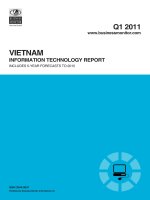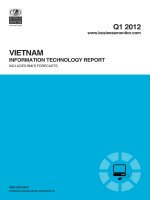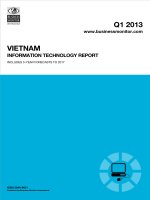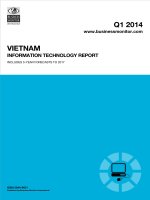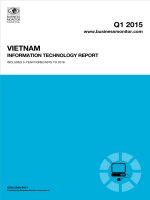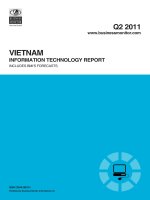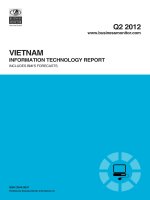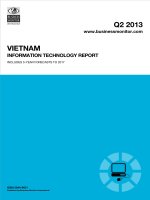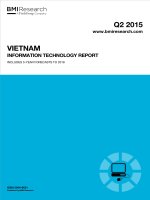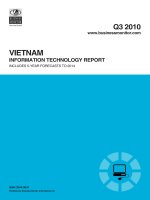Vietnam information technology report q2 2012
Bạn đang xem bản rút gọn của tài liệu. Xem và tải ngay bản đầy đủ của tài liệu tại đây (549.48 KB, 62 trang )
Q2 2012
Published by Business Monitor International Ltd.
www.businessmonitor.com
INFORMATION TECHNOLOGY REPORT
ISSN 2044-9631
Published by Business Monitor International Ltd.
VIETNAM
INCLUDES BMI'S FORECASTS
Business Monitor International
85 Queen Victoria Street
London
EC4V 4AB
UK
Tel: +44 (0) 20 7248 0468
Fax: +44 (0) 20 7248 0467
Email:
Web:
© 2012 Business Monitor International.
All rights reserved.
All information contained in this publication is
copyrighted in the name of Business Monitor
International, and as such no part of this publication
may be reproduced, repackaged, redistributed, resold in
whole or in any part, or used in any form or by any
means graphic, electronic or mechanical, including
photocopying, recording, taping, or by information
storage or retrieval, or by any other means, without the
express written consent of the publisher.
DISCLAIMER
All information contained in this publication has been researched and compiled from sources believed to be accurate and reliable at the time of
publishing. However, in view of the natural scope for human and/or mechanical error, either at source or during production, Business Monitor
International accepts no liability whatsoever for any loss or damage resulting from errors, inaccuracies or omissions affecting any part of the
publication. All information is provided without warranty, and Business Monitor International makes no representation of warranty of any kind as
to the accuracy or completeness of any information hereto contained.
VIETNAM INFORMATION
TECHNOLOGY REPORT
Q2 2012
INCLUDES 5-YEAR FORECASTS TO 2016
Part of BMI's Industry Report & Forecasts Series
Published by: Business Monitor International
Copy deadline: April 2012
Vietnam Information Technology Report Q2 2012
© Business Monitor International Ltd Page 2
Vietnam Information Technology Report Q2 2012
© Business Monitor International Ltd Page 3
CONTENTS
Executive Summary 5
SWOT Analysis 7
Vietnam IT SWOT 7
Vietnam Telecoms SWOT 8
Vietnam Political SWOT 9
Vietnam Economic SWOT 10
Vietnam Business Environment SWOT 11
Risk/Reward Ratings 12
Table: Asia IT Risk/Reward Ratings Q212 17
Asia IT Markets Overview 18
IT Penetration 18
IT Growth And Drivers 20
Sectors And Verticals 21
Vietnam IT Markets Overview 25
Government Authority 25
Hardware 26
Software 28
Services 32
Industry Developments 33
Industry Forecast 37
Table: Vietnam IT Sector – Historical Data & Forecasts, 2009-2016 40
Industry Forecast Internet 41
Table: Telecoms Sector – Internet – Historical Data And Forecasts, 2009-2016 41
Macroeconomic Forecast 43
Table: Vietnam – Economic Activity 45
Competitive Landscape 46
Hardware 46
Software 47
IT Services 51
Company Profiles 55
FPT Software 55
Country Snapshot: Vietnam Demographic Data 56
Section 1: Population 56
Table: Demographic Indicators, 2005-2030 56
Table: Rural/Urban Breakdown, 2005-2030 57
Section 2: Education And Healthcare 57
Table: Education, 2002-2005 57
Table: Vital Statistics, 2005-2030 57
Section 3: Labour Market And Spending Power 58
Vietnam Information Technology Report Q2 2012
© Business Monitor International Ltd Page 4
Table: Employment Indicators, 1999-2004 58
Table: Consumer Expenditure, 2000-2012 (US$) 58
BMI Methodology 59
How We Generate Our Industry Forecasts 59
Transport Industry 59
Sources 60
Vietnam Information Technology Report Q2 2012
© Business Monitor International Ltd Page 5
Executive Summary
BMI View: Vietnamese IT spending is expected to reach US$2.5bn in 2012, up 14%, with BMI upwardly
revising its forecast after the PC market reported double-digit growth in H111. Factors such as rising
PC penetration, economic growth, a range of government ICT initiatives and a drive to develop
Vietnam's domestic IT industry will help to sustain continued expansion going forward. Vietnam's
improving ICT infrastructure will also drive the development of the nation's IT market in a country with
below 20% PC penetration.
Headline Expenditure Projections
Computer hardware sales: US$1.6bn in 2011 to US$1.8bn in 2012, +12% in US dollar terms. Forecast
in US dollar terms upwardly revised due to stronger than expected retail sales growth in 2011.
Software sales: US$187mn in 2011 to US$220mn in 2012, +18% in US dollar terms. Forecast in US
dollar terms upwardly revised due to analyst modification but will depend on the success in bringing
down illegal software use.
IT Services sales: US$396mn in 2011 to US$369mn in 2012, +19% in US dollar terms. Forecast in US
dollar terms upwardly revised due to analyst modification with growing demand for digital
infrastructure projects in segments such as banking, telecoms, energy and government.
Risk/Reward Ratings: Vietnam's score was 33.2 out of 100.0. Vietnam ranks 11th in our latest Asia
RRR table, ahead of Sri Lanka. The country ranked ninth for its IT market score of 36.
Key Trends & Developments
The Vietnam IT market is expected to grow around 12% in 2012. Government and business IT
spending remain subject to fiscal restraints and external economic headwinds, and the
devaluation of the dong will also inhibit demand. However the Vietnamese economy is expected
to remain generally strong and drive growth in IT investments.
In 2011, a number of government ministries and organisations, including the Ministry of
Education and Training, started to promote the roll-out of cloud services. Plans to modernise IT
in government agencies and the customs department, as well as the Tax Administration
Modernization Plan for 2008-2013 represent opportunities for vendors of IT products and
services.
Vietnam Information Technology Report Q2 2012
© Business Monitor International Ltd Page 6
An ambitious government IT plan for 2010-2020 should shape many segments of the
Vietnamese IT market.The government's increasing focus on encouraging ICT development and
foreign investment in the tech sector will also create opportunities. Many of the government's
ICT development plans and programmes are still in a nascent stage and their ultimate
effectiveness is yet to be determined.
Vietnam Information Technology Report Q2 2012
© Business Monitor International Ltd Page 7
SWOT Analysis
Vietnam
IT SWOT
Strengths
The domestic IT market is in a rapid growth phase, with trade liberalisation and growing
affordability driving projected double-digit growth of notebook computers.
Expanding ICT infrastructure and internet penetration will continue to drive demand for IT
products and services.
Vietnam's gradual integration into the global trade network via its accession into trade
organisations such as ASEAN and WTO, as well as bilateral agreements with Japan and
China.
Weaknesses
IT spend per capita much lower than in neighbouring Thailand, reflecting a much lower
GDP and GDP per capita.
Low levels of access to credit and budgets restrain spending by SMEs.
Highly cost-sensitive market, with 75% of software provided by lower-cost local software
vendors.
High level of software piracy at 85%, although it has fallen in the last few years.
Opportunities
High PC market growth potential particular in rural areas due to overall low PC
penetration rate of 15%.
Vast and relatively under-penetrated rural market presents a significant growth
opportunity as the government rolls out measures to boost rural connectivity and incomes.
National IT Plan will drive spending on IT utilisation in areas like e-government, e-taxation
and education.
SMEs have much potential to increase spending on basic solutions, including customer
relationship management and security.
One Teacher-One Computer programme aims to deliver 1mn computers to schools by
2011.
The banking and finance sector is a promising area for database software and one where
foreign companies have done well.
Banking and finance, oil and gas, aviation and telecoms are projected to be some of the
biggest opportunities for multinational vendors.
Tax agencies at all levels of administration are looking to increase the efficiency of tax
collection.
The government's drive to create a significant IT services industry over the next 15-20
years is expected to be a significant factor shaping the IT market.
Threats
Continued depreciation of the dong against the US dollar would increase the pressure on
Vietnamese distributors of foreign IT goods.
Falling prices may further undermine margins and profitability after steep discounting in
2009.
The implementation of the China-ASEAN free trade agreement means that established
multinationals will face a growing challenge from low-cost Chinese vendors in the
Vietnamese market.
Vietnam Information Technology Report Q2 2012
© Business Monitor International Ltd Page 8
Vietnam
Telecoms SWOT
Strengths
Fixed-line penetration levels and internet user rates are high in major urban centres such
as Ho Chi Minh City, Hanoi, Danang and Haiphong.
Competition exists in fixed-line and internet access markets; VNPT faces competition
from several other state-owned companies and two privately-owned operators.
High levels of literacy and other demographic factors bode well for strong and continued
demand for wireline services over the next few years.
Weaknesses
Vietnam's fixed-line and internet access markets are both dominated by state-controlled
operators, VNPT and Viettel.
Although alternative broadband infrastructures are currently being explored, broadband
growth continues to be dependent on DSL.
Low fixed-line penetration rates in rural regions limit the scope for DSL broadband
growth.
Internet user growth is slowing, despite the limited access to internet infrastructure in
much of rural Vietnam.
Broadband tariffs remain high, creating a barrier for low-income subscribers to access.
Opportunities
The privatisation of VNPT could help to bring about increased investment revenues and
the arrival of new skills.
On a national level, broadband penetration rates remain low; this means that the sector
has considerable growth potential.
VNPT plans to invest US$1bn in 2009, in order to upgrade its broadband networks and
expand its international internet bandwidth.
Significant opportunities exist to develop alternative broadband technologies, including
WiMAX and fibre.
WiMAX services are currently being trialled with a view to licensing a number of WiMAX
service providers in the near future; WiMAX internet services have the potential to raise
the level of internet user penetration in rural parts of Vietnam.
Draft Bill of Law on Telecommunication has been put forward for discussion at the
National Assembly Steering Committee. If passed, the bill will allow private companies to
build network infrastructure for the first time and will open up the telecoms market to
foreign investors.
Threats
Fixed-line sector may enter a period of decline, with potentially negative consequences
for ADSL growth.
As the market for mobile data services grows, this could have potentially negative
consequences for the growth of fixed broadband services.
Slower economic growth in 2009 and 2010 could undermine wireline investment and
expansion plans.
Vietnam Information Technology Report Q2 2012
© Business Monitor International Ltd Page 9
Vietnam Political SWOT
Strengths
The Communist Party of Vietnam remains committed to market-oriented reforms and
we do not expect major shifts in policy direction over the next five years. The one-
party system is generally conducive to short-term political stability.
Relations with the US have witnessed a marked improvement, and Washington sees
Hanoi as a potential geopolitical ally in South East Asia.
Weaknesses
Corruption among government officials poses a major threat to the legitimacy of the
ruling Communist Party.
There is increasing (albeit still limited) public dissatisfaction with the leadership's tight
control over political dissent.
Opportunities
The government recognises the threat corruption poses to its legitimacy, and has
acted to clamp down on graft among party officials.
Vietnam has allowed legislators to become more vocal in criticising government
policies. This is opening up opportunities for more checks and balances within the
one-party system.
Threats
Macroeconomic instabilities in 2012 are likely to weigh on public acceptance of the
one-party system, and street demonstrations to protest economic conditions could
develop into a full-on challenge of undemocractic rule.
Although strong domestic control will ensure little change to Vietnam's political scene
in the next few years, over the longer term, the one-party-state will probably be
unsustainable.
Relations with China have deteriorated over recent years due to Beijing's more
assertive stance over disputed islands in the South China Sea and domestic criticism
of a large Chinese investment into a bauxite mining project in the central highlands,
which could potentially cause wide-scale environmental damage.
Vietnam Information Technology Report Q2 2012
© Business Monitor International Ltd Page 10
Vietnam Economic SWOT
Strengths
Vietnam has been one of the fastest-growing economies in Asia in recent years, with
GDP growth averaging 7.1% annually between 2000 and 2011.
The economic boom has lifted many Vietnamese out of poverty, with the official
poverty rate in the country falling from 58% in 1993 to 9.5% in 2010.
Weaknesses
Vietnam still suffers from substantial trade, current account and fiscal deficits, leaving
the economy vulnerable to global economic uncertainties in 2012. The fiscal deficit is
dominated by substantial spending on social subsidies that could be difficult to
withdraw.
The heavily-managed and weak currency reduces incentives to improve quality of
exports, and also keeps import costs high, contributing to inflationary pressures.
Opportunities
WTO membership has given Vietnam access to both foreign markets and capital,
while making Vietnamese enterprises stronger through increased competition.
The government will in spite of the current macroeconomic woes, continue to move
forward with market reforms, including privatisation of state-owned enterprises, and
liberalising the banking sector.
Urbanisation will continue to be a long-term growth driver. The UN forecasts the urban
population rising from 29% of the population to more than 50% by the early 2040s.
Threats
Inflation and deficit concerns have caused some investors to re-assess their hitherto
upbeat view of Vietnam. If the government focuses too much on stimulating growth
and fails to root out inflationary pressure, it risks prolonging macroeconomic instability,
which could lead to a potential crisis.
Prolonged macroeconomic instability could prompt the authorities to put reforms on
hold as they struggle to stabilise the economy.
Vietnam Information Technology Report Q2 2012
© Business Monitor International Ltd Page 11
Vietnam Business Environment SWOT
Strengths
Vietnam has a large, skilled and low-cost workforce, that has made the country
attractive to foreign investors.
Vietnam's location – its proximity to China and South East Asia, and its good sea links
– makes it a good base for foreign companies to export to the rest of Asia, and
beyond.
Weaknesses
Vietnam's infrastructure is still weak. Roads, railways and ports are inadequate to
cope with the country's economic growth and links with the outside world.
Vietnam remains one of the world's most corrupt countries. According to
Transparency International's 2011 Corruption Perceptions Index, Vietnam ranks 112
out of 183 countries.
Opportunities
Vietnam is increasingly attracting investment from key Asian economies, such as
Japan, South Korea and Taiwan. This offers the possibility of the transfer of high-tech
skills and know-how.
Vietnam is pressing ahead with the privatisation of state-owned enterprises and the
liberalisation of the banking sector. This should offer foreign investors new entry
points.
Threats
Ongoing trade disputes with the US, and the general threat of American protectionism,
which will remain a concern.
Labour unrest remains a lingering threat. A failure by the authorities to boost skills
levels could leave Vietnam a second-rate economy for an indefinite period.
Vietnam Information Technology Report Q2 2012
© Business Monitor International Ltd Page 12
Risk/Reward Ratings
BMI's Asia Pacific IT
Risk/Reward Ratings (RRR)
compares the potential of a
selection of the region's markets
over our forecast period through
to 2016. Our Q212 ratings reflect
our consideration of the political
and economic risks, as well as
the risks associated specifically
with IT intellectual property (IP)
rights protection and the
implementation of state spending
projects.
There were several changes to
the country rankings as we fine-
tuned our methodology to better
reflect the market conditions. In
this quarter's update, highly urbanised Singapore overtook Australia by outperforming the latter in three
out of the four components. Although Singapore's IT market is smaller than that of Australia, Singapore
has other redeeming factors. For one, Singapore is strategically placed at the heart of South East Asia
amid emerging markets such as Indonesia and Thailand. Its strong infrastructure, political stability and
pro-business environment attract foreign investors and spur technological developments.
Singapore's ambitions to emerge as a regional cloud computing hub will fuel vendor investment in service
capabilities. Moreover, ambitious projects such as the national healthcare register and the schools
standard operating environment will bolster the IT market. Singapore benefits from high broadband
penetration and initiatives such as the government's ambitious Intelligent Nation 2015 plan.
Singaporean spending on IT services will be boosted by the continuing boom in IT-enabled services such
as call centres and back-office financial services. Other promising sectors for IT services include
healthcare, as the government launches a series of initiatives to develop health technology.
Although Australia fell to second position, it still has a respectable IT Rating of 70.9, which was
significantly higher than the regional average of 50.2. Due to the sheer mass of the country, it is inevitable
that certain regions suffer from a deficiency in IT services. However, the government has been looking to
Developed Countries Have Their Heads Above
The Rest
Asia Pacific IT Risk/Reward Ratings Q212
Source: BMI
Vietnam Information Technology Report Q2 2012
© Business Monitor International Ltd Page 13
resolve the issue with its ambitious National Broadband Network (NBN), which aims to deliver
nationwide high-speed broadband connectivity with a combination of fibre, fixed-wireless and satellite
technologies. Furthermore, a number of leading Australian private and public sector organisations have
launched cloud initiatives, including many of the country's leading banks, while the government has also
unveiled a six-year cloud computing strategy.
IT verticals such as the government, telecoms, healthcare and banking should continue to supply demand
for implementation, consulting and managed services in the future. Meanwhile, the NBN should drive the
development of Australia's digital economy and feed demand for personal computers and mobile devices.
There were no changes to Hong Kong's IT Rating score or position on the table. Hong Kong has one of
the lowest fibre broadband tariff rates in the world, and this provides the backbone for next generation IT
services such as cloud computing and data centres. While we expect robust IT market growth in Hong
Kong due to the increasing investment opportunities arising from its growing links with the vast Chinese
market, we also highlight that the outlook for 2012 is looking more uncertain as we envisage a hard
landing in China.
Similar to its developed peers in the region, South Korea is also encouraging the utilisation of cloud
computing by small businesses. New cloud computing offerings and increased competition in this
segment are expected to fuel growing demand to use this technology. IT outsourcing is also expected to
show a strong demand trajectory. The government has also identified the potential and importance of
software development, highlighted by the ascendency of mobile operating system (OS) Android, and has
announced a plan to develop an open-source OS with domestic ICT firms. Regardless of whether the
project would succeed, it shows the forward-looking stance of the South Korean government and its
commitment to drive IT developments in the sector.
Vietnam Information Technology Report Q2 2012
© Business Monitor International Ltd Page 14
While the South Korean
consumers have exhibited strong
appetite for IT products, we
expect private consumption to be
subdued in the near term. South
Korea's household debt quandary
leaves the economy in a
precarious position. While lower
interest rates have reduced the
risks of an implosion in the
household debt market, high debt
levels still place a substantial
constraint on consumption
spending. A deteriorating
economy is likely to place
considerable weight on
consumers' debt repayment
ability as incomes are likely to
get slashed while the jobless rate ticks up. A combination of seasonal factors, as well as a worsening
economy should keep downward pressure on consumer spending going into 2012.
Malaysia remains in fifth position in our Q212 regional ratings. Recent developments such as a slowdown
in production activity and falling commodity prices, which will exacerbate the slowdown in mining
production, continue to support our view that Malaysia's economic growth will witness a significant
slowdown in 2012. Consequently, government spending may become more constrained because of
commitments to tackle the budget deficit, but there will be growth areas. IT spending growth will be
driven by the government's drive for greater household broadband penetration of 75% by 2015.
The rollout of a Malaysian high-speed fibre broadband network will boost IT spending outside the Klang
Valley. Other projected growth and PC market drivers include a rise in the PC penetration level from
about 35%, tax exemptions for notebooks and growth in disposable incomes.
There are increasingly attractive opportunities in the IT services area as the government implements
measures to make Malaysia a growing regional services and outsourcing hub. Guiding the government
and industry is the country's Economic Transformation Programme, which has earmarked areas such as
cloud computing as one of its top 10 strategic technology priorities.
Country Structure A Letdown
Asia Pacific IT Risk/Reward Ratings Q212
Source: Q212
Vietnam Information Technology Report Q2 2012
© Business Monitor International Ltd Page 15
One of BMI's key macro themes for Asia Pacific in 2012 is a growth slowdown across the board with
recession risks highest in countries such as Australia, Hong Kong and Singapore due to factors such as a
slowdown in the US and Europe as well as a Chinese hard landing.
2012 may be the year in which China's economy goes from – as the title of our China Special Report in
October 2011 put it – 'Miracle To Meltdown'. We have warned for years about the imbalances inherent in
the Chinese economic growth model, which are characterised by a major overemphasis on investment at
the expense of consumption, underpinned by unsustainable credit expansion. Now, several indicators
point to a Chinese hard landing. While the definition of hard landing is up for debate, we generally
consider it to include the following characteristics: a contraction in manufacturing output as reported by
the purchasing manager index (PMI) surveys; a contraction in services sector PMI; a sustained fall in
imports; double-digit house price declines; elevated banking sector stress; and growing expectations of
currency weakness.
A Chinese economic slowdown would negatively affect the IT market growth, albeit at a lesser extent
than other industries such as infrastructure or automotives. Factors such as the vast potential rural market
and a commitment to modernisation in sectors such as education, healthcare and manufacturing are
among the expected drivers. We expect growing interest in cloud computing will be stimulated by the
establishment of government pilot programmes. However, there are still market risks associated with IP
rights protection in China as well as piracy and a lack of business transparency.
In the Philippines, the IT market will be driven by the local IT and business process outsourcing (BPO)
sector. The BPO industry, which accounts for around 30% of IT spending, continues to grow. The
Philippines has a low PC penetration, like many other developing Asian countries, and the IT market
offers corresponding high growth potential over the forecast period. The Philippines is also looking at
cloud computing as the next growth driver, with the private sector leading the charge. Domestic firms
have partnered with foreign IT companies in order to provide the necessary infrastructure and technology
to expand their products portfolio, which should attract businesses including small and medium-sized
enterprises (SMEs) as they look to cut costs amid an uncertain global economy.
India's IT industry possesses significant growth potential as only a small portion of the country's massive
population has access to a personal computer. Significant opportunities will also be created by demand
from Indian businesses and government agencies to help use more advanced IT solutions to improve
efficiency and reduce costs. Consequently, India had a relatively high IT Market score of 49.0. However,
the country was significantly let down by its weak Country Structure score.
India is in the midst of a significant cyclical slowdown. Industrial production growth stalled to a 21-
month low of 3.3% year-on-year in July 2011, led by a downturn in both capital goods and consumer
durables activity. The latter is of particular concern from a GDP accounting perspective given that
Vietnam Information Technology Report Q2 2012
© Business Monitor International Ltd Page 16
households make up the lion's share of GDP (at an estimated 62% in FY2010/11), and in line with our
view, the Indian consumer has started to tighten spending on 'big ticket' purchases. Although many Indian
private and public sector organisations have started to consider upgrading their IT infrastructure, further
deterioration in the global economy could once again force them to scale back on investments.
The global consumer electronics industry has been severely disrupted by the flooding in Thailand, as
output of key components for hard disk drives by Thai plants has been dramatically cut. Companies that
were directly affected by the disaster have announced that they are looking to relocate some of their
operations to alternative countries in order to diversify risk and minimise disruptions, which is a blow to
the Thai IT sector.
However, we retain an overall bullish stance due to the Thai government's flood rehabilitation and IT
proliferation plans. We expect the launch of more compatible products to leverage on the long-awaited
launch of 3G services. Intel predicts that ultrabooks could account for as much as 40% of the notebooks
sold in Thailand in 2012, although BMI has a more conservative forecast as we foresee tablet computers
as a serious threat. Meanwhile, the Thai government has earmarked the ICT industry as an important
growth driver. Besides a plan for 3G operators to provide broadband and Wi-Fi services freely available
in schools nationwide as part of a universal social obligation initiative, the government also has a One
Tablet Per Child project, which intends to bridge the digital and education divide.
With ICT penetration of only about 20% and development restricted to richer areas such as Java, the
Indonesian IT market has much growth potential. BMI expects the Indonesian market to be one of the
fastest growing in the region over the five-year forecast period. Spending in some key IT verticals, such
as financial services and banking should continue to be significant in 2012. Government IT spending is
also expected to increase and could have accounted for as much as 25% of the IT market. The SME sector
will drive demand for basic hardware and applications as enterprises focus on enhanced productivity.
Sri Lanka's IT market has benefited from the restoration of peace and improvements in the security
situation, which helped release pent-up demand for IT solutions. The country has felt the effects of
instability over the years, from disruption of distribution channels and a flourishing grey market to the
underdeveloped telecoms infrastructure. However, Sri Lanka will feature on IT vendors' radars as one of
the best potential growth prospects in South Asia. Computerisation has only started in government
services. Major public and private sector organisations remain largely underpenetrated in terms of basic
enterprise software.
However, initiatives such as network expansion projects by telecoms providers to increase internet
penetration rates in Sri Lanka and free training tools for SMEs from the International Finance Corporation
(a member of the World Bank Group) to boost adoption of IT services cloud help the country to close the
gap with its regional peers.
Vietnam Information Technology Report Q2 2012
© Business Monitor International Ltd Page 17
Table: Asia IT Risk/Reward Ratings Q212
Limits Of Potential Returns Risks To Realisation Of Potential Returns
Country IT Market
Country
Structure
Limits
Market
Risks
Country
Risk
Risks IT Rating
Regional
Rank
Singapore 57.0 100.0 72.1 70.0 85.1 79.0 74.1 1
Australia 55.5 95.0 69.3 80.0 71.2 74.7 70.9 2
Hong Kong 48.3 95.0 64.7 70.0 87.4 80.4 69.4 3
South Korea 53.3 75.0 60.9 75.0 71.4 72.8 64.5 4
Malaysia 41.3 55.0 46.1 35.0 76.7 60.0 50.3 5
China 53.1 30.0 45.0 35.0 68.4 55.1 48.0 6
Philippines 39.3 45.0 41.3 42.5 52.2 48.3 43.4 7
India 49.0 15.0 37.1 45.0 55.6 51.3 41.4 8
Thailand 37.5 20.0 31.4 35.0 72.6 57.6 39.2 9
Indonesia 37.5 35.0 36.6 35.0 51.6 45.0 39.1 10
Vietnam 38.1 15.0 30.0 35.0 44.2 40.5 33.2 11
Sri Lanka 30.0 10.0 23.0 35.0 44.2 40.5 28.3 12
Scores are weighted as follows: 'Rewards': 70%, of which Industry Rewards 65% and Country Rewards 35%; 'Risks':
30%, of which Industry Risks 40% and Country Risks 60%. The 'Rewards' rating evaluates the size and growth
potential of a telecoms market in any given state, and country's broader economic/socio-demographic characteristics
that impact the industry's development; the 'Risks' rating evaluates industry specific dangers and those emanating
from the state's political/economic profile, based on BMI's proprietary Country Risk Ratings that could affect the
realisation of anticipated returns. Source: BMI
Vietnam Information Technology Report Q2 2012
© Business Monitor International Ltd Page 18
Asia IT Markets Overview
IT Penetration
Across Asia, government ICT initiatives and
growing affordability will help to drive increases
in PC penetration during BMI's five-year forecast
period. While some cities and regions stand out,
there is an unbalanced pattern of regional
development, with PC penetration in countries
such as Singapore above 50%, while in other
countries, such as Indonesia, it is below 5%.
The two Asian leaders, China and India, embody
the region's growth potential, as in both countries
computer ownership remains the preserve of a
minority. In China, PC penetration was only
around 25% in 2010 – although it was far higher in cities such as Shanghai and Beijing and urban PC
penetration is projected to pass 60% by 2015. In India, less than 5% of people own a computer. However,
some 45% of the population is under 25, which provides a promising demographic context for increased
PC ownership. PC penetration in Vietnam was estimated by BMI at around 15% in 2010. Notebooks are
owned by an estimated 7% of the Vietnamese population, which points to significant growth potential for
the local PC market.
Lower prices will help to drive higher PC
penetration in developing markets. The average
price of a PC in the Indian market has nearly
halved over the past few years, and rising incomes
and greater credit availability will continue to
bring computers within the reach of lower-income
demographics. Even in more mature markets, there
is room for development, however, with official
data suggesting that as many as 25% of Hong
Kong households do not have a computer at home.
Around the region, affordable computer
programmes continue to find favour with
governments. In China, a subsidised household electronics products initiative aimed at rural residents has
Narrowband Penetration
Per 100 Population
e/f = estimate/forecast. Source: BMI
Broadband Penetration
Per 100 Population
e/f = estimate/forecast. Source: BMI
Vietnam Information Technology Report Q2 2012
© Business Monitor International Ltd Page 19
helped to boost PC sales in areas where penetration was low. In Australia in 2010, national and state
governments continued to roll out new initiatives, with the Victoria government investing more than
US$150mn in IT in schools.
In Indonesia, PC penetration of around 2% could double by 2013 if government initiatives are followed
through. The Indonesian government is also rolling out new e-learning initiatives, with a target of raising
the current 1:3,200 ratio of PCs to students in public schools to 1:20. Meanwhile, in 2010, the Vietnamese
government launched a programme entitled One Teacher-One Computer, which offered discounts on PCs
for teachers and students.
A similarly broad range is found with respect to internet penetration. The highest levels of internet
penetration are found in Singapore, South Korea, Hong Kong and Australia, with estimated 2011
penetration rates of 78.5%, 76.4% and 75.5% and 67.4% respectively. Singapore has by far the highest
rate of broadband penetration, which was estimated at 160.2% in 2011. Meanwhile, the Philippines has
the one of lowest levels of internet usage, with just 7.1% narrowband and 6.1% broadband penetration
estimated in 2011.
The fastest growth is expected in Indonesia, where internet penetration is projected to leap from 36% in
2011 to 67.4% by 2015. India is now at above 28% internet penetration despite a lack of fixed-line
infrastructure, and this should reach 36% by 2015. Steady growth is also projected for Sri Lanka, where
penetration is projected to increase from 14.1% to 19.4% by 2015. Some 60.4% of Malaysians had
internet access in 2010.
Dial-up technology is still the dominant access method in many states. However, even in developing
markets, the number of broadband subscribers continues to gain ground steadily. Broadband penetration
has been boosted by growing numbers of mobile broadband users, as 3G mobile services are expanded
across the region. In China, broadband penetration is on course to reach 33.1% by 2015. In India,
penetration should increase sixfold to reach 9.4% by 2015 from around 1.5% currently, although this
remains below government targets. Singapore will also see continued strong growth in broadband
penetration, which is projected to reach 186% by 2015.
Across the region, government programmes are an important driver of ICT penetration. The Chinese
government has a five-year plan to make the internet available in every administrative village in central
and eastern China and every township in the west. In Australia, the government's commitment to develop
the National Broadband Network should further the development of Australia's digital economy.
Meanwhile, the growth of Wi-Fi coverage will be one driver of notebook sales in places such as Hong
Kong, where the government has committed another HKD200mn to the deployment of a Wi-Fi network
covering more than 200 public venues.
Vietnam Information Technology Report Q2 2012
© Business Monitor International Ltd Page 20
IT Growth And Drivers
Across the region in 2011, IT spending should
benefit from improved economic circumstances
and tenders, previously deferred as a result of the
economic situation, although much will depend on
business confidence. Strong fundamental demand
drivers of IT spending mean that there will be
continued opportunities. Key factors common to
most markets include cheaper PCs and reform in
sectors such as telecommunications and finance,
as well as government initiatives.
In some of the region's largest markets, such as
China, lower-tier cities and towns will be among
the fastest growing segment of the IT market. BMI expects China's IT market growth to be driven by an
expansion into western China and rural areas well as growing demand from small and medium-sized
enterprises (SMEs). The Chinese IT market will also receive a boost in 2011 from a 50% increase in
import tariffs on some electronics products,
such as laptops.
In Thailand in 2011, demand will be bolstered
by market expansion in the relatively
underpenetrated rural areas. SIS forecasts that
market growth in upcountry areas will be 30%
in 2011, double that forecast for the country as
a whole. A similar situation pertains to India
where in 2011 there are expected to be strong
growth opportunities in smaller cities.
The long-term potential of India's IT market is
plain: less than 3% of people in India own a
computer (about one-fifth of the level in
China), meaning particular potential in the lower-end product range. India's IT market appears to be
positioned for strong growth thanks to an improving economy and consumer sentiment, and government
support for modernisation in lagging sectors. Meanwhile, India's business process outsourcing industry is
growing at around 40% per annum and will continue to generate opportunities for vendors of IT products
and services.
2011e IT Market Sizes
US$mn
e = estimate. Source: BMI
IT Market Sizes
As % Of National GDPs
e/f = estimate/forecast. Source: BMI
Vietnam Information Technology Report Q2 2012
© Business Monitor International Ltd Page 21
The Philippines is one of the countries
currently benefiting from low-priced PC
programmes (PC4ALL), which provide
opportunities for vendors to penetrate the low-
income segments. Other regional computer sale
drivers over the forecast period include
education, lower prices, IP telephony, cheaper
processors as well as notebook entertainment
and wireless networking features. Meanwhile,
in Indonesia, the basic demographics of rising
computer penetration and growing affordability
should drive growth. SMEs represent a growth
opportunity, as currently only around 20% of
Indonesian SMEs are estimated to make use of
IT. Compliance with government and international regulations will be a driver in financial, manufacturing
and other sectors.
In more developed markets, such as Hong Kong and Singapore, robust retail sales led the way in early
2010 as spending recorded positive growth following a contraction in 2009. In Hong Kong consumer
spending is expected to remain strong in 2010, as evidenced by the positive early reception for Apple's
iPad. IT market growth will be driven by government IT spending as well as cross-border trade and
cooperation.
The largest IT market in the region is, unsurprisingly, China, estimated at US$105.4bn in 2011, trailed
distantly by Australia (US$20.8bn), India (US$19.7bn) and South Korea (US$17.8bn.) Singapore's IT
market (including communications) is the largest as a proportion of national GDP (2.2%), followed by
Hong Kong (2.1%). Thailand's IT market was affected last year by a number of exogenous events
including floods in the north east of the country, and political unrest. However, in 2011 the country looks
to be back on track.
The fastest growing IT markets over the forecast period are projected to be India and Indonesia with
2011-2015 compound growth of 109% and 91% respectively, driven by increasing PC penetration. Sri
Lanka is third with the IT market growing by an estimated 89% over BMI's five-year forecast period,
while China's total growth is estimated at a still healthy 70%.
Sectors And Verticals
Regional IT markets remain hardware-centric, with hardware accounting for 25-74% of total spending in
all markets in 2010. However, spending on software and services will grow faster. Notebook sales are
IT Markets Compound Growth
2011e-2015f (%)
e/f = estimate/forecast. Source: BMI
Vietnam Information Technology Report Q2 2012
© Business Monitor International Ltd Page 22
growing much faster than the PC market as a whole with growth driven by falling prices and more
features.
In mature markets such as Australia and Singapore, PC sales are dominated by replacement sales. In
Australia, upgrades are estimated to account for at least 80% of business purchases and more than 50% in
the case of households. More than 90% of Australian households now have a PC, but consumers have
appeared willing to spend on upgrading their notebook computers and it is also becoming more popular to
purchase a second household PC. Indeed, around 30% of households have more than one PC.
Tablet sales will lead to a new PC market growth area, with triple-digit growth projected in many
markets. In China it is estimated that tablets could account for around 6-7% of computer sales in 2011.
However, partly thanks to the tablets surge, demand for netbooks has lost momentum in some markets.
Sales, although initially promising, have sometimes fallen short of perhaps unrealistic expectations. In
Australia, netbooks sales growth slowed from the first quarter of 2010, and this has continued into 2011.
In less developed markets, demand from under-penetrated rural areas, affordable computer programmes
and growing broadband penetration should generally drive growth. In China, as in much of emerging
Asia, demand from smaller towns and rural areas where PC penetration is relatively low will provide the
main source of growth. Another driver will be replacement of desktops with notebooks. SMEs will be one
of the strong growth segments over the forecast period, with SME demand for servers and networking
equipment a significant growth opportunity.
Falling prices is another major driver, placing pressure on margins. As of the third quarter of 2010, the
average price of a PC in China was estimated to have fallen to around US$600, considerably below the
price level in developed markets. In India, the average price of a PC has nearly halved over the past few
years, and rising incomes and greater credit availability will continue to bring computers within the reach
of lower income demographics.
In both emerging and more mature markets, the growing popularity of broadband will help to support
computer sales. China Telecom is among regional telecoms companies to have rolled out PC bundling
offers as part of its broadband packages. Meanwhile, broadband plans will also help to popularise tablets.
At the end of 2010, Australian telecoms operators such as Telstra were competing to offer affordable
tablets bundled with data services.
Meanwhile, a wave of 3G launches across the region should also provide a stimulus to sales of notebooks,
with Vodafone Hong Kong among service providers offering 3G/HSPA USB modems bundled with
their 3G services. However, netbooks and notebooks face competition from other form factors such as
smartphones from Palm, RIM, Apple and other vendors, and tablet notebooks, spearheaded by Apple's
iPad,
Vietnam Information Technology Report Q2 2012
© Business Monitor International Ltd Page 23
Due in part to high levels of piracy, software's share of IT spending is relatively low, ranging from 9-25%
among countries covered by BMI. Efforts are being made to tackle the issue of piracy, but despite
government crackdowns in China and the Philippines, software piracy remains above 70% in most of
emerging Asia.
In 2011, sales of Microsoft's Windows 7 operating system and new Intel core technology retain the
potential to help trigger hardware upgrades, although much will depend on business confidence.
Hundreds of large enterprises and thousands of small enterprises in China have already started migrating
to Windows 7, and this process is expected to continue in 2011.
Across the region there is a growing trend for smaller companies to seek greater efficiency by using IT to
improve productivity and reduce costs (including labour costs). As Asian companies have become more
integrated into the global supply chain, their multinational business partners often encourage them to
install backoffice systems to meet efficiency requirements.
In general, enterprise resource planning (ERP) and other e-business products still dominate the enterprise
software market, but vendors are also looking to other areas such as customer relationship management
(CRM) and business intelligence, where faster growth is possible. Although the market remains relatively
small, more companies are looking at computing solutions such as Software-as-a-Service (SaaS). Cloud
computing business models such as SaaS offer smaller businesses a cost-effective way to deliver
applications such as payroll, tax-return processing and recruitment.
The hosted application model may already account for between one-fifth and one-quarter of Chinese
software revenue and SaaS has also enjoyed steady growth in the Hong Kong market over the past few
years. Improved broadband infrastructure will assist the popularisation of the rented software model in
markets such as Indonesia. Meanwhile, around one-third of Australian organisations already use some
cloud computing.
New platforms and services in the telecoms field is a driver for that key IT spending segment, where an
industry restructuring with the advent of 3G mobile services has led to more competition. Meanwhile,
expanding technology adoption in the logistics industry and public transport will be a source of IT
services projects. Sectors such as hospitals and real estate will also provide opportunities.
The IT services segment accounts for 17-40% of spending in the Asian markets covered by BMI. The
global economic slowdown and credit tightening had an impact on projects in some verticals, but in 2010,
a brightening business climate should mean more opportunities in key IT-spending verticals such as
Financial Services, Telecoms, Government, Healthcare and Logistics.
Vietnam Information Technology Report Q2 2012
© Business Monitor International Ltd Page 24
Government spending will account for a larger share of spending in many markets. In China, government
stimulus packages have helped to drive IT-related investments, while in Singapore government ICT
projects such as SOE2 provide significant opportunities. Meanwhile, the Hong Kong government's
Digital 21 initiative will continue to generate spending.
Regionally, hardware deployment services remain the largest IT services category, with other
fundamental services including system integration, support systems, training, professional services,
outsourcing and internet services. Main spenders across the region include banks and financial institutions
as well as governments. Even in emerging markets such as India, IT vendors are having to pay more
attention to value-added services such as technical support and product troubleshooting, or basic IT and
hardware consulting.
In many countries, the number and size of local outsourcing deals are increasing. Outsourcing could
account for as much as 30% of China's IT services spending by 2013, while in India there have been some
large contracts such as that awarded by Idea Cellular to IBM. Singapore and Hong Kong have both seen
a trend towards larger outsourcing projects in the public and private sectors.
Market Structure (% Of Total IT Market)
2011e
2015f
e/f = estimate/forecast. Source: BMI
